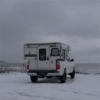Edit (Jan 11): FWC responded to my email, and suggested I ground the inverter ground post to the negative terminal of the battery directly.
Edited by phudz, 11 January 2024 - 11:32 PM.

Posted 08 January 2024 - 04:49 PM
Edit (Jan 11): FWC responded to my email, and suggested I ground the inverter ground post to the negative terminal of the battery directly.
Edited by phudz, 11 January 2024 - 11:32 PM.
Posted 08 January 2024 - 10:56 PM
Phudz,
I installed an Aims Power 1500w inverter in my Hawk Shell to run off the camper battery.
Here is what the instructions had to say:
CONNECTION
1. Grounding
The power inverter has a terminal on the rear panel marked " Grounding "or "≡".
This is used to connect the chassis of the power inverter to ground. The ground
terminal has already been connected to the ground wire of the AC output
receptacle through the inverter.
The ground terminal must be connected to the ground wire, which will vary
depending on where the power inverter is installed. In a vehicle, connect the
ground terminal to the chassis of the vehicle. In a boat, connect it to the boat’s
ground system. In a fixed location, connect the ground terminal to earth.
I did connect the ground terminal on the inverter to a negative bus bar at the camper battery, which is connected via 2 AWG cable to the truck battery negative terminal (and chassis). That way I don't have an extra ground wire connection to remember if/when I remove the camper.
Posted 09 January 2024 - 02:12 AM
Phudz,
I installed an Aims Power 1500w inverter in my Hawk Shell to run off the camper battery.
Here is what the instructions had to say:
CONNECTION
1. Grounding
The power inverter has a terminal on the rear panel marked " Grounding "or "≡".
This is used to connect the chassis of the power inverter to ground. The ground
terminal has already been connected to the ground wire of the AC output
receptacle through the inverter.
The ground terminal must be connected to the ground wire, which will vary
depending on where the power inverter is installed. In a vehicle, connect the
ground terminal to the chassis of the vehicle. In a boat, connect it to the boat’s
ground system. In a fixed location, connect the ground terminal to earth.
I did connect the ground terminal on the inverter to a negative bus bar at the camper battery, which is connected via 2 AWG cable to the truck battery negative terminal (and chassis). That way I don't have an extra ground wire connection to remember if/when I remove the camper.
Thanks for weighing in. This is what I was leaning toward doing.
Now to decide which inverter to go with. I found someone selling some used Magnum Dimensions CSW1012 pure sine wave inverters for $69 on eBay. For the price, it might be worth trying out. Otherwise, I'm leaning toward the Renogy 1000w unit unless someone can convince me with another similarly priced unit.
Posted 09 January 2024 - 01:09 PM
To provide some 120 volt AC capability, I simply added a Bluetti EB70S power station to my shell unit and called it good. It has the added benefit of providing USB and USB C ports for recharging those devices that need it. The built in AC inverter is limited to 800 watts.
Andrew in Austin, TX
Posted 09 January 2024 - 01:57 PM
To provide some 120 volt AC capability, I simply added a Bluetti EB70S power station to my shell unit and called it good. It has the added benefit of providing USB and USB C ports for recharging those devices that need it. The built in AC inverter is limited to 800 watts.
I currently have a portable power station with an attached ~500w modified sine wave inverter, that I built to power a diesel heater and some electronics for a few days. It's my temporary solution for now.
However, it's one more battery to have to keep topped up, which also takes up space I could otherwise use.
Posted 09 January 2024 - 06:05 PM
I have an AIMS 3000W pure sine in my camper. It has been rock solid. I usually love Victron gear, but the Victron inverter I had broke shortly after I got it. Nothing electronic, just the silly little attachment block they had on the outside snapped off. Granted that was a smaller unit that didn't have big studs to attach huge cables to.
0 members, 0 guests, 0 anonymous users